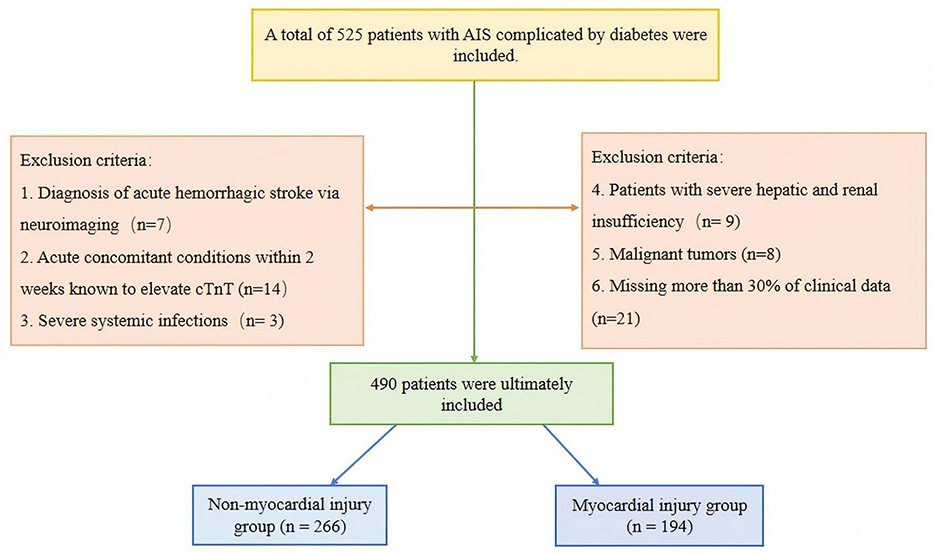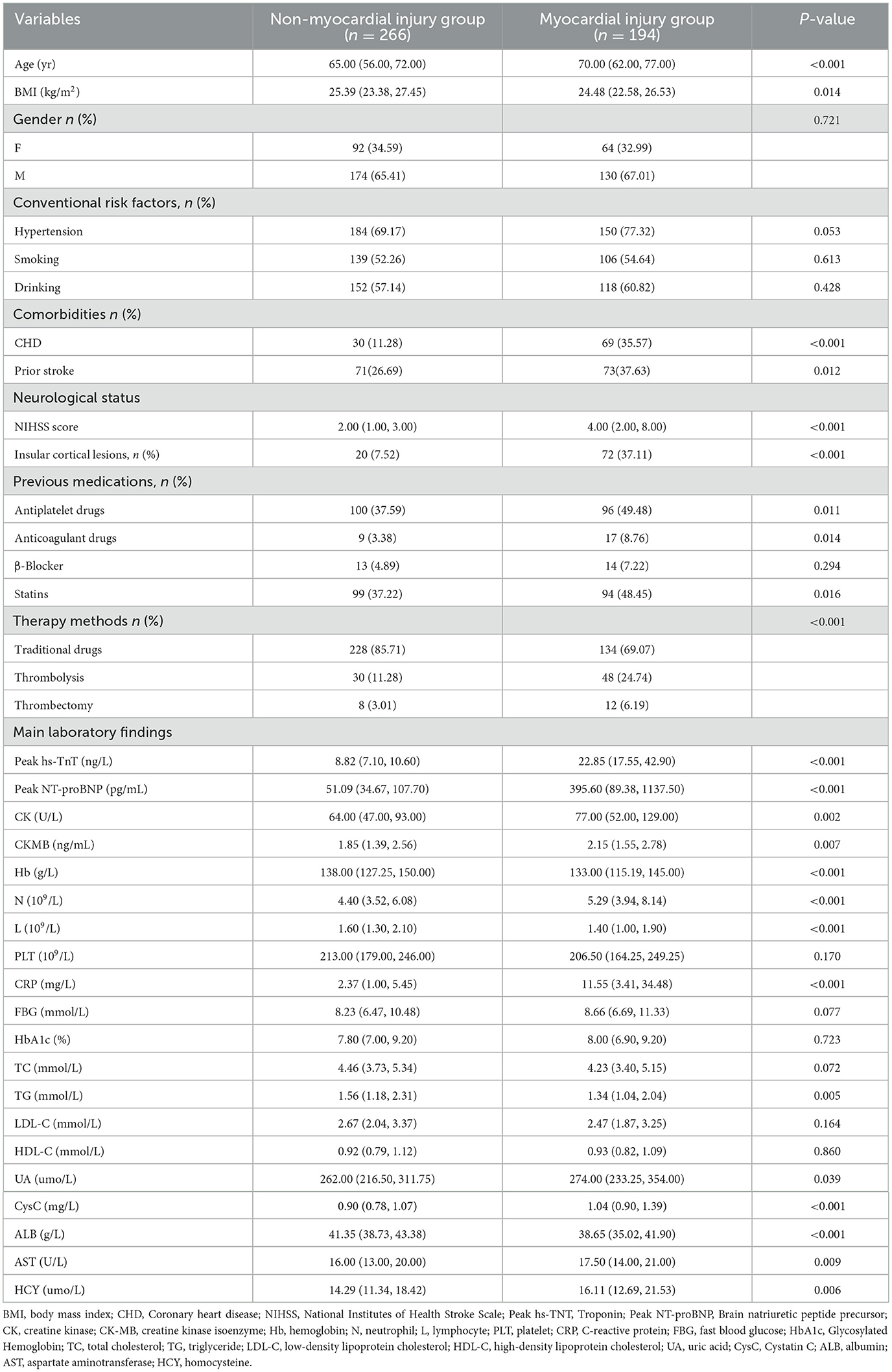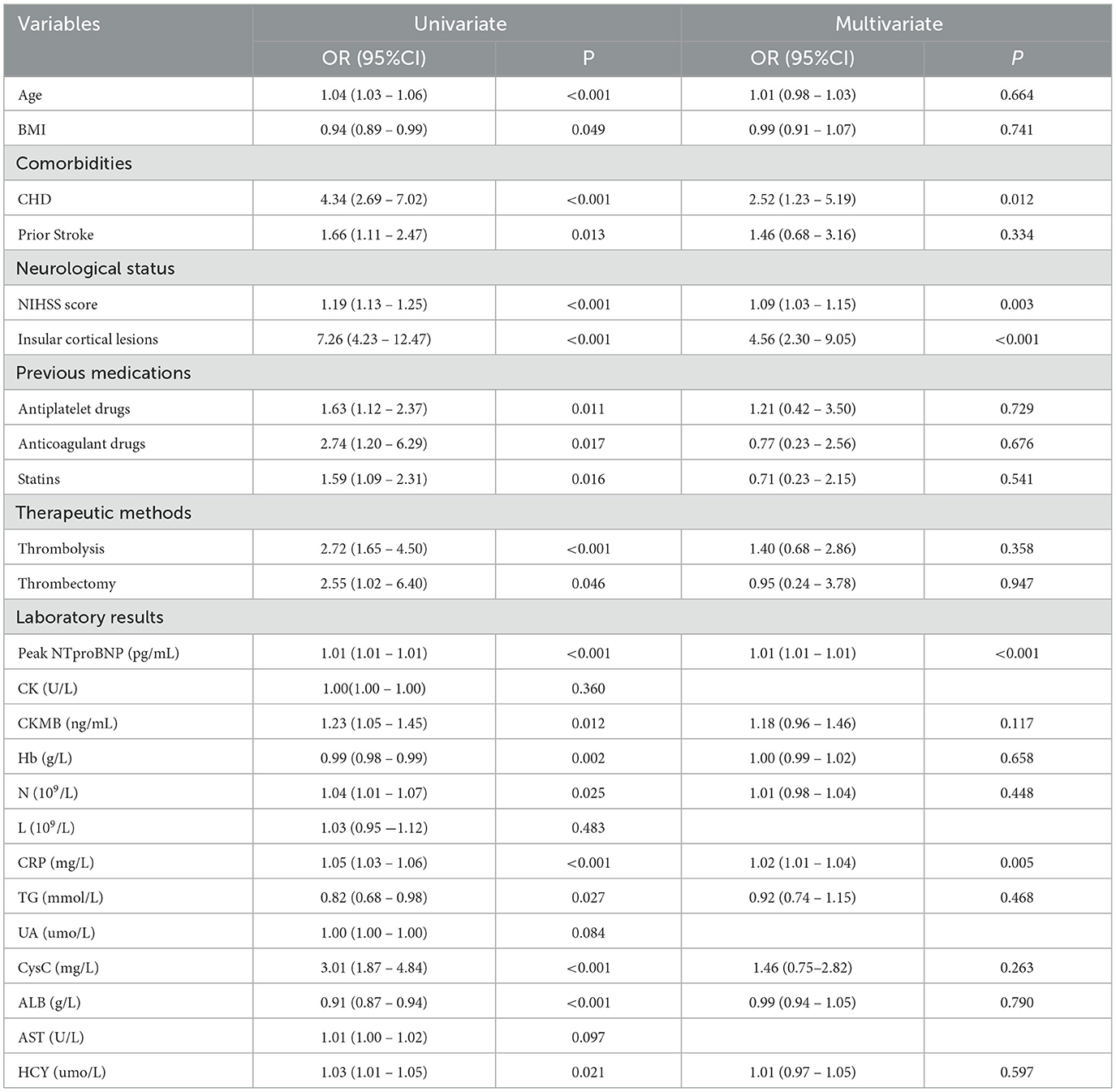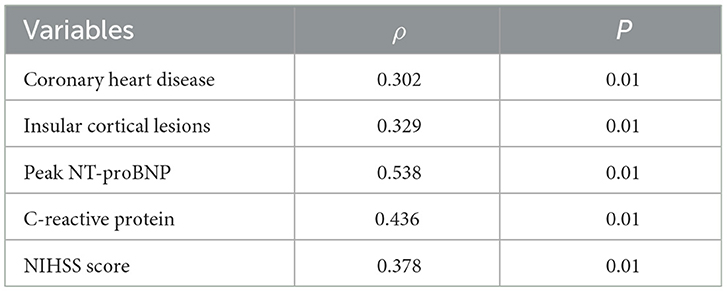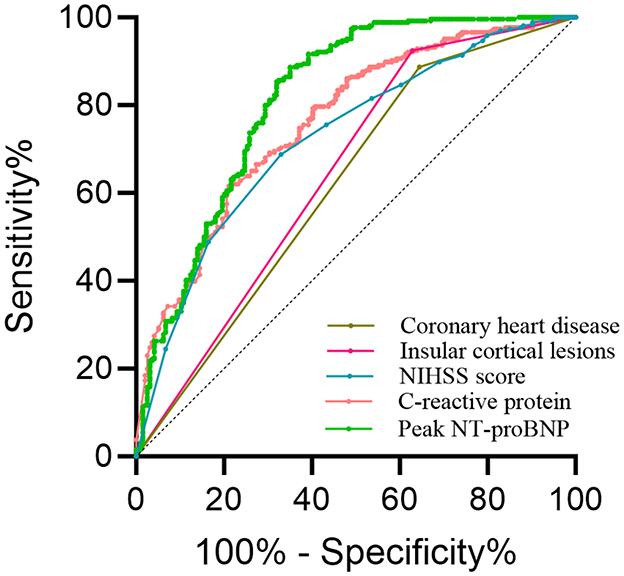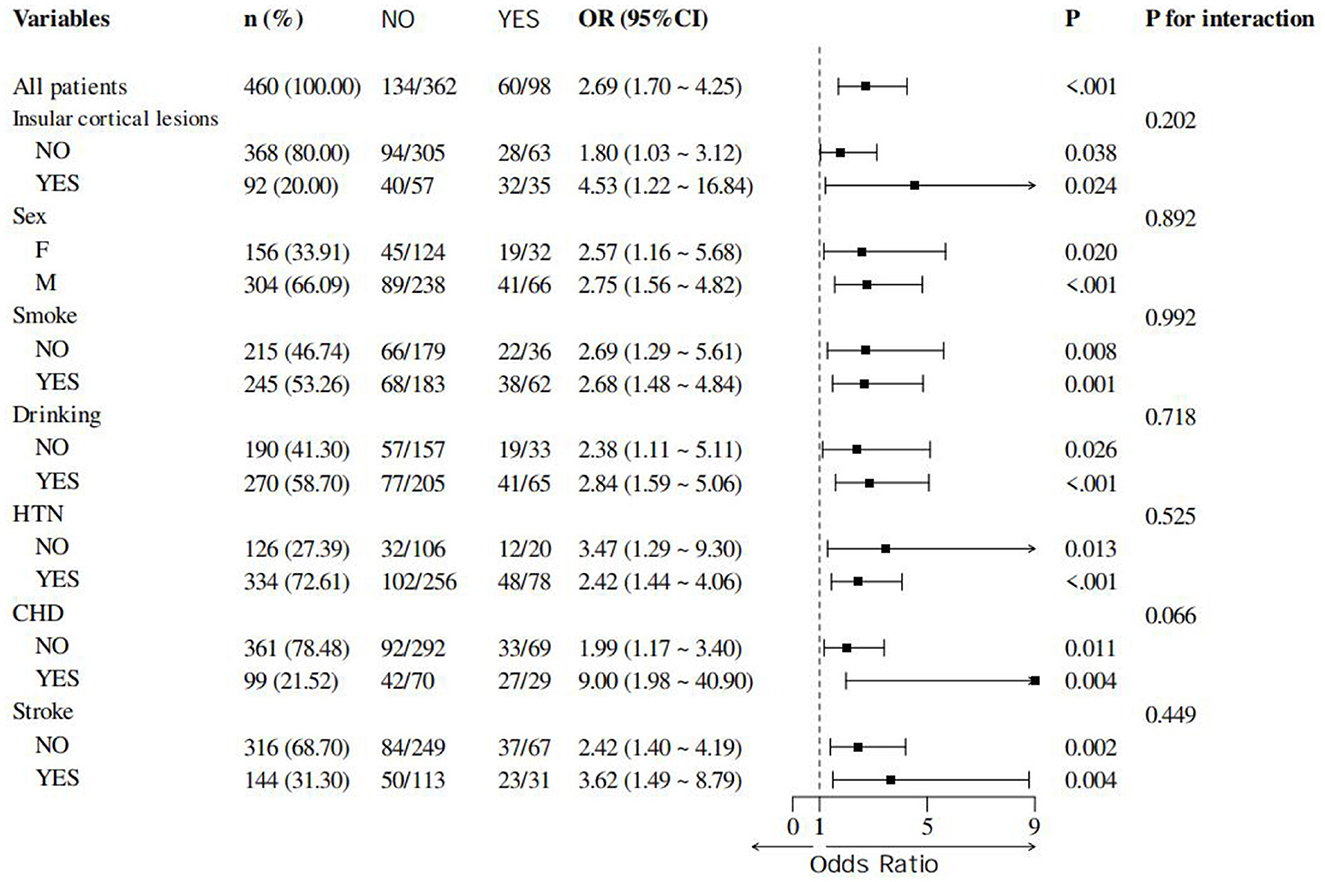- 1Department of General Practice, The Affiliated Hospital of Xuzhou Medical University, Xuzhou, China
- 2Department of Cardiology, The Affiliated Hospital of Xuzhou Medical University, Xuzhou, China
- 3Department of Geriatric Medicine, The Affiliated Hospital of Xuzhou Medical University, Xuzhou, China
Background: Ischemic stroke (IS) causes significant death and disability. Stroke-Heart Syndrome (SHS) involves cardiovascular complications, worsening outcomes. Diabetes mellitus (DM) increases the risk of myocardial injury following IS. This study explores risk factors for myocardial injury in acute ischemic stroke (AIS) with DM patients to improve early identification and prevention.
Methods: This is a retrospective cohort study. Inclusion criteria: neuroimaging-confirmed AIS, admission within 72 h, and measured cardiac troponinT (cTnT) levels. Exclusion criteria included acute hemorrhagic stroke, other cTnT elevation causes, severe organ failure, infections, malignancies, and missing data. Logistic and LASSO regression analyses identified independent risk factors for myocardial injury.
Results: Myocardial injury occurred in 194 patients. Independent risk factors identified were coronary heart disease (CHD), insular cortex lesions, peak brain natriuretic peptide precursor (peak NT-proBNP), C-reactive protein (CRP), and higher National Institutes of Health Stroke Scale (NIHSS) scores. These factors were significantly associated with myocardial injury and ROC analysis showed that the AUC for CHD was 0.621, the AUC for insular cortex lesions was 0.648, the AUC for NIHSS score was 0.726, the AUC for peak NT-proBNP was 0.816 and the AUC for CRP was 0.764. Subgroup analysis suggested that reperfusion therapy was associated with increased myocardial injury risk in various patient subgroups.
Conclusion: CHD, insular cortex lesions, peak NT-proBNP and CRP levels, and higher stroke severity (NIHSS score) are significant risk factors for myocardial injury in AIS patients with DM.
1 Introduction
Stroke, is a disease caused by acute disorder of cerebral blood circulation and the third leading cause of death worldwide (Tadi and Lui, 2025; GBD 2021 Stroke Risk Factor Collaborators, 2024). It is estimated that by 2030, ~22 million people will die or suffer from disability due to stroke (GBD 2021 Stroke Risk Factor Collaborators, 2024; Pu et al., 2023). Among the different types of stroke, of which ischemic stroke (IS) is the most prevalent of type, accounting for ~65.3% stroke (GBD 2021 Stroke Risk Factor Collaborators, 2024).
Recent studies have highlighted a close relationship between the central nervous system and the cardiovascular system. Stroke not only directly impacts brain function but also exerts profound effects on the heart through neuroendocrine pathways, a phenomenon known as Stroke-Heart Syndrome (SHS) (Sposato et al., 2020). The SHS can be classified into 5 main categories: (1) ischemic and non-ischemic acute myocardial injury presenting with elevated cardiac troponin (cTn), which is usually asymptomatic; (2) post-stroke acute myocardial infarction (AMI); (3) left ventricular (LV) dysfunction, heart failure (HF), and post-stroke Takotsubo syndrome (TTS); (4) electrocardiographic changes and cardiac arrhythmias including post-stroke atrial fibrillation (AF); and (5) post-stroke neurogenic sudden cardiac death (Sposato et al., 2020). The pathophysiology of SHS is primarily related to autonomic nervous dysfunction, neurohormonal disturbances, and immune-inflammatory responses, which can increase cardiac load and subsequently accelerate myocardial cell injury (Ishiguchi et al., 2024). Studies have shown that SHS is associated with poor functional outcomes and is the second leading cause of death during the first few weeks following a stroke (Scheitz et al., 2018). Given the strong correlation between acute ischemic stroke (AIS) and cardiac events, the American Heart Association/American Stroke Association guidelines recommend the measurement of cardiac troponin (cTn) as a biomarker of myocardial injury in all patients with suspected stroke (Powers et al., 2018). The incidence of myocardial injury in patients with ischemic stroke can be as high as 27.2% (Mihalovic et al., 2023). Previous studies have shown that myocardial injury is associated with poor outcomes and increased mortality (Hess et al., 2025). Therefore, preventing and treating post-stroke myocardial injury is crucial for improving the prognosis of stroke patients.
Identifying and addressing the risk factors for myocardial injury are crucial for the prevention and treatment of post-stroke myocardial injury. Previous studies have indicated that the occurrence of myocardial injury in stroke patients is influenced by various factors, including age, a history of cardiac complications, metabolic disorders, and infarct location, which may be key determinants of myocardial injury (Johansen et al., 2024). Diabetes mellitus (DM), as a common chronic metabolic disease, plays a decisive role in triggering cardiovascular and cerebrovascular events (Maida et al., 2022). A meta-analysis has shown that the risk of IS in DM patients is 2.27 times higher compared to non-diabetic individuals. Moreover, DM patients have a 2- to 4-fold increased risk of developing cardiac events following a stroke compared to non-diabetic patients (Chen et al., 2016). Previous studies have indicated that diabetes is a major risk factor for acute myocardial infarction and IS, both of which are closely associated with atherosclerosis. However, in the Honolulu Heart Program's prospective study, the relative risk of ischemic thromboembolic stroke in DM patients was found to be 2.0 (95% CI, 1.4–3.0), even when other atherosclerosis related conditions, such as hypertension, hypercholesterolemia, and sedentary lifestyle, were strictly controlled, the impact of DM on stroke remained significant. Consequently, DM has been identified as an independent risk factor for IS (Maida et al., 2022).
The mechanism by which diabetes increases stroke is not fully understood. One possible mechanism is that DM patients often experience autonomic neuropathy, which may lead to an imbalance in the cardiac autonomic nervous system, thereby increasing the risk of myocardial injury (Lin et al., 2020). Additionally, insulin resistance and hyperinsulinemia, common in DM patients, may result in metabolic disturbances in the heart, further impairing cardiac function (Chen et al., 2017). Furthermore, DM patients are generally in a heightened inflammatory state with elevated oxidative stress levels, which may exacerbate myocardial damage (Yan et al., 2020).
Considering the close relationship between DM and cardiovascular events, this study aims to investigate the potential risk factors for myocardial injury in patients with AIS and concomitant DM. The findings could provide scientific evidence for the early identification and prevention of risk factors associated with post-stroke myocardial injury.
2 Methods
2.1 Study population
We retrospectively identified patients with AIS who were admitted to the Affiliated Hospital of Xuzhou Medical University between January 2021 and December 2023. AIS diagnosis was made according to the 2019 guidelines (Powers et al., 2019). The inclusion criteria were as follows: (1) Diagnosis of AIS based on neuroimaging; (2) Hospital admission within 72 hours of symptom onset; (3) Measurement of cardiac troponin T (cTnT) upon admission; (4) Patients with elevated cTnT upon admission, with at least one additional cTnT measurement within 48 h. The exclusion criteria were: (1) Diagnosis of acute hemorrhagic stroke via neuroimaging (Greenberg et al., 2022); (2) Acute concomitant conditions within 2 weeks known to elevate cTnT, including acute myocardial infarction, worsening of congestive heart failure, major cardiac surgery, sepsis, acute kidney injury, rhabdomyolysis, pulmonary embolism, and infective endocarditis; (3) Severe systemic infections; (4) Severe hepatic or renal insufficiency, defined as liver dysfunction (Child-Pugh class C or MELD score ≥ 15) or kidney dysfunction (end-stage renal disease on dialysis or eGFR < 15 mL/min/1.73 m2); (5) Malignant tumors; (6) Missing more than 30% of clinical data (Figure 1).
2.2 Data collection
Patient demographic data [age, sex, and body mass index (BMI)], traditional cardiovascular risk factors (hypertension, smoking, and alcohol consumption), comorbidities [coronary heart disease (CHD) and prior stroke], previous medication use (focusing on antiplatelet agents, anticoagulants, β-blockers, and statins), stroke treatment modalities (conventional drug therapy, thrombolysis, and mechanical thrombectomy), neurological function as assessed by the National Institutes of Health Stroke Scale (NIHSS) (Adams et al., 1999) to evaluate stroke severity, and the location of the ischemic lesion in the insular cortex, determined using diffusion-weighted magnetic resonance imaging, were also considered, along with relevant laboratory data.
2.3 Outcomes
The primary outcomes of this study was myocardial injury following AIS. The criteria for myocardial injury include the detection of an elevated cTn value above the 99th percentile upper reference limit (URL) (McCarthy et al., 2019). The injury is considered acute if there is a rise and/or fall of cTn values (>20%) (Thygesen et al., 2018). While stable elevation of cTnT levels may occur in various chronic cardiac conditions, a dynamic change in cTnT levels is specific to acute, evolving myocardial injury (Mahajan and Jarolim, 2011).
2.4 Statistical analysis
Statistical analysis was performed using SPSS version 27.0 and R Studio version 4.3.1. The Kolmogorov-Smirnov test and Levene's test were used to evaluate the normality and homogeneity of variance of continuous variables, respectively. Normally distributed data are presented as mean ± standard deviation (x ± s) and were compared using the independent samples t-test. Non-normally distributed data are expressed as median (M) with interquartile range (IQR) M(P25, P75) and compared using the Mann–Whitney U-test. Categorical variables were analyzed using the chi-square test. Variables showing significant differences between groups and potentially influencing myocardial injury were included in univariate logistic regression analysis. Variables with P < 0.05 in the univariate analysis were subjected to least absolute shrinkage and selection operator (LASSO) regression to identify non-zero coefficients, followed by multivariate logistic regression to determine independent risk factors for myocardial injury. These factors were further evaluated using receiver operating characteristic (ROC) curve analysis. Spearman's correlation was applied to assess the relationship between myocardial injury and the identified independent risk factors and to evaluate their diagnostic value.
3 Results
3.1 Baseline characteristics
A total of 490 patients with AIS complicated by DM were included in this study. Among these, 266 patients did not develop myocardial injury, while 194 patients exhibited myocardial injury. Patients in the myocardial injury group were older and had a higher BMI compared to those in the non-myocardial injury group. Furthermore, the myocardial injury group had a higher prevalence of comorbidities, more severe neurological deficits, and a greater incidence of insular cortex lesions. A higher proportion of patients in the myocardial injury group had a history of antiplatelet, anticoagulant, and lipid-lowering medication use. They also received reperfusion therapies, including thrombolysis and thrombectomy, more frequently than the non-myocardial injury group.
In terms of laboratory findings, patients with myocardial injury had significantly higher levels of cTnT, peak brain natriuretic peptide precursor (Peak NT-ProBNP), creatine kinase (CK), creatine kinase isoenzyme (CK-MB), neutrophil (N) count, C-reactive protein (CRP), uric acid (UA), cystatin C (CysC), aspartate aminotransferase (AST), and homocysteine (HCY). Conversely, they had lower levels of hemoglobin (Hb), lymphocyte (L) count, triglycerides, and albumin (ALB) compared to the non-myocardial injury group (Table 1).
3.2 Logistic regression analyses and LASSO regression
The indicators that showed significant differences between the two groups and were considered potential factors influencing myocardial injury were selected as independent variables, with myocardial injury as the dependent variable. Univariate logistic regression analysis identified age, BMI, CHD, stroke history, NIHSS score, insular cortical lesions, antiplatelet therapy, anticoagulant therapy, statin use, therapeutic methods, peak NT-proBNP, CK-MB, Hb, N count, CRP, TG, CysC, ALB, and HCY as factors significantly associated with myocardial injury (p < 0.05) (Table 2). These variables were then included in a LASSO regression analysis, which identified age, CHD, NIHSS score, insular cortex lesions, peak NT-proBNP, CRP, CysC, and ALB as risk factors for myocardial injury in patients with AIS and DM (Figure 2). And multivariate logistic regression analysis confirmed that CHD, NIHSS score, insular cortex lesions, peak NT-proBNP, and CRP were independent risk factors for myocardial injury in AIS patients with concurrent DM (Table 2).
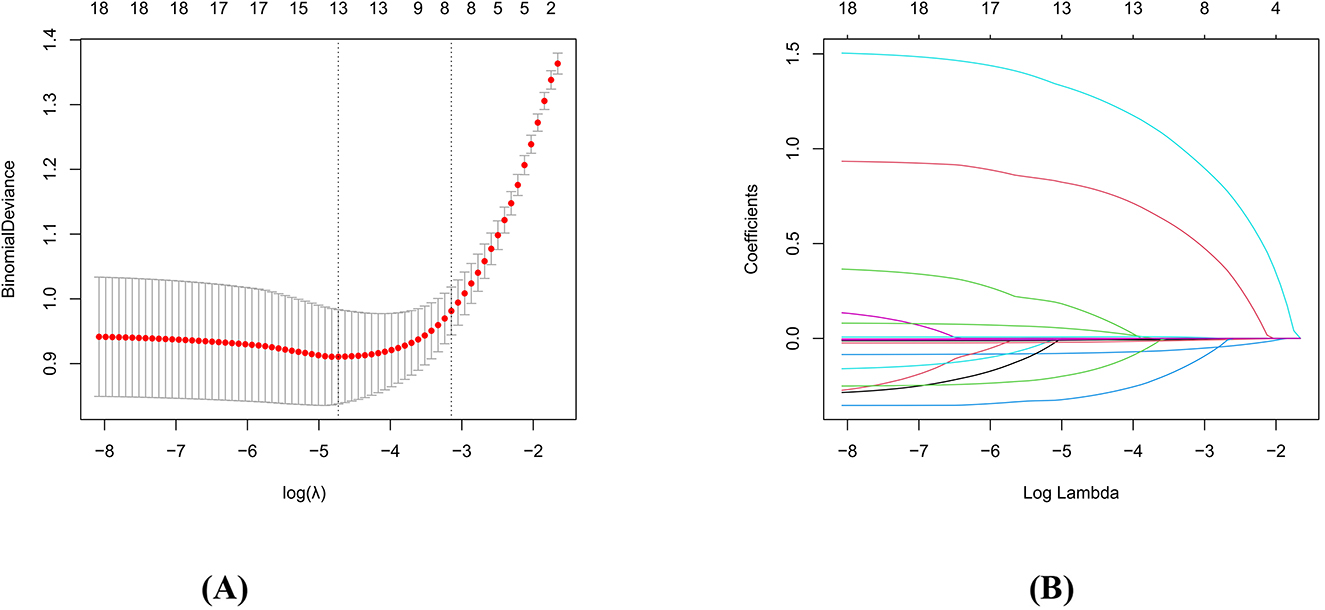
Figure 2. LASSO regression model screening risk factors of myocardial-injury. (A) LASSO regression model cross-validation plot. Draw a vertical line at the optimum with the minimum criterion and 1se of the minimum criterion. When λ =0.027020, we get 8 variables for further analysis. (B) Coefficient profile plot of risk factors. Finally, eight variables were selected at the optimal lambda, which is consistent with the results selected.
3.3 Correlation analysis
cTnT was significantly positively correlated with the following risk factors (Coronary heart disease: ρ = 0.302, p < 0.01; Insular cortical lesions: ρ = 0.329, p < 0.01; Peak NT-proBNP: ρ = 0.538, p < 0.01; C-reactive protein: ρ = 0.436, p < 0.01; NIHSS score: ρ = 0.378, p < 0.01). In this study, cTnT was most strongly correlated with Peak NT-proBNP (Table 3).
3.4 ROC curve analysis
Patients with AIS and DM exhibit an elevated risk of myocardial injury. CHD, Insular cortex lesions, NHISS Score, peak NT-proBNP, and CRP were identified as independent risk factors for myocardial injury in this cohort. To assess the diagnostic utility of these factors, receiver operating characteristic (ROC) curve analysis was performed to determine the area under the curve (AUC) for each variable. The AUC values were as follows: 0.621 for CHD, 0.648 for insular cortex lesions, 0.726 for NIHSS score and a cut-off value of 2.5, 0.816 for peak NT-proBNP and a cut-off value of 193.5, and 0.764 for CRP and a cut-off value of 3.125 (Figure 3).
3.5 Subgroup analysis of reperfusion therapy
Subgroup analyses revealed a statistically significant overall effect of reperfusion therapy on myocardial injury across the entire study population. And the effect of reperfusion therapy on myocardial injury was consistent across all seven pre-specified subgroups, with no interaction (all interaction p-values >0.05). However, it did not affect the relationship between the two (Figure 4).
4 Discussion
Previous studies have reported a myocardial injury incidence of 27.2% in IS patients. In contrast, this study found a higher incidence of 39.59%, which may be attributed to the inclusion of DM patients. DM is an independent risk factor for cardiovascular and cerebrovascular diseases and may increase the risk of post-stroke myocardial injury through mechanisms such as cardiac metabolic dysfunction, oxidative stress, and inflammation. This could explain the higher myocardial injury incidence observed in this study.
In this single-center retrospective cohort study, CHD, insular cortex lesions, peak NT-proBNP, CRP, and NIHSS score were identified as significant risk factors for myocardial injury, with these factors positively correlated with the severity of myocardial injury.
A previous study by Song et al. (2024) investigated the relationship between CHD and post-stroke myocardial injury, identifying a history of CHD as one of the significant causes of myocardial injury after stroke. The underlying mechanism may involve the presence of coronary atherosclerosis or stenosis in CHD patients, leading to inadequate myocardial oxygen supply, which further increases the risk of myocardial injury under the stress condition of acute ischemic stroke (Song et al., 2024). CHD is closely associated with systemic inflammation, which plays a key role in atherosclerosis and thrombosis (Wang et al., 2024). After acute ischemic stroke, inflammation may exacerbate the existing myocardial injury (Wang et al., 2024). Additionally, CHD patients often experience reduced myocardial energy metabolism efficiency, and diabetes can worsen endothelial dysfunction and coronary microvascular impairment, further increasing the risk of post-stroke myocardial injury (Wang et al., 2024; Sourour et al., 2024). In this study, CHD was found to be a risk factor for myocardial injury, with CHD patients being more likely to develop myocardial injury (OR 2.52, 95% CI 1.23–5.19), consistent with the findings of Song et al. (2024). Krause et al. (2017) conducted foundational research demonstrating that the insular cortex is a critical regulatory center of the central autonomic network, involved in the modulation of both sympathetic and parasympathetic control of the heart in response to emotional and physical stress. Scheitz et al. (2021) utilized voxel-based lesion-symptom mapping and confirmed that right dorsolateral anterior insular cortex lesions are associated with changes in post-stroke cTnT levels. In this study, patients with insular cortex lesions exhibited a higher incidence of myocardial injury. Moreover, in the subgroup analysis of reperfusion therapy, patients with insular lesions had a higher rate of reperfusion treatment, suggesting that their condition may be more severe.
The severity of stroke and post-stroke mortality have been linked to various biomarkers, with different natriuretic peptide levels correlating with stroke severity and mortality (Johansen et al., 2024). In a study involving 788 ischemic stroke patients, brain natriuretic peptide (BNP) levels were significantly associated with 90-day post-stroke mortality, while another study found BNP to be independently correlated with functional outcomes at 90 days (Hellwig et al., 2021; Hatab et al., 2023; Nigro et al., 2014). Research by Nigro et al. (2014) revealed that BNP levels were associated with recurrent vascular events after stroke, and even after adjusting for heart failure and cardioembolic stroke etiology, NT-proBNP remained an independent predictor of post-stroke mortality. In this study, peak NT-proBNP was identified as a risk factor for myocardial injury following stroke, with a strong correlation, consistent with previous findings.
Recent experimental studies support the critical role of inflammatory responses in the pathophysiology of SHS (Fan et al., 2024). In stroke mouse models, cardiac dysfunction is primarily accompanied by systemic inflammation, upregulation of pro-inflammatory cytokines in myocardial tissue, and infiltration of macrophages into the heart (Yan et al., 2020; Vornholz et al., 2021). Post-stroke adverse outcomes are linked to blood-brain barrier disruption, which may promote neutrophil and macrophage infiltration into ischemic brain tissue, a process that plays a crucial role in maintaining the integrity of the neurovascular unit in ischemic stroke models (Barca et al., 2021). Furthermore, excessive sympathetic nervous system activation can trigger the migration of inflammatory cells from the bone marrow or spleen. Previous studies have indicated that the spleen plays a key role in the subacute and long-term outcomes of stroke-induced heart syndrome, ultimately contributing to chronic remodeling (Scheitz et al., 2022). In this study, we observed that inflammation is correlated with myocardial injury.
The NIHSS score is a widely used tool for assessing neurological function in acute stroke patients and correlates with stroke severity. A prospective study has demonstrated that NIHSS scores are associated with elevated cTnT levels (OR, 1.05; 95% CI, 1.02–1.07) (Ahn et al., 2023). In this study, patients with myocardial injury had higher NIHSS scores, reflecting more severe neurological deficits.
The risk factors identified in this study are well-supported by existing evidence; however, several limitations should be acknowledged. (1) This study is a single-center, retrospective analysis with a relatively small sample size, which may limit the generalizability of the findings. Future multicenter, prospective studies are needed to further explore the potential risk factors involved. (2) The study lacks quantitative imaging data, which precludes an examination of the impact of stroke lesion volume on myocardial injury. Future research will aim to incorporate such data to provide a more comprehensive analysis.
5 Conclusion
The results of this study indicate that CHD, insular cortex lesions, peak NT-proBNP, CRP, and NIHSS score are independent risk factors for myocardial injury in patients with AIS and DM. These findings provide valuable evidence for the early identification of risk factors for myocardial injury and for the implementation of early interventions.
Data availability statement
The raw data supporting the conclusions of this article will be made available by the authors, without undue reservation.
Ethics statement
The studies involving humans were approved by the Ethics Committee of the Affiliated Hospital of Xuzhou Medical University. The studies were conducted in accordance with the local legislation and institutional requirements. The human samples used in this study were acquired from a by- product of routine care or industry. Written informed consent for participation was not required from the participants or the participants' legal guardians/next of kin in accordance with the national legislation and institutional requirements.
Author contributions
HP: Conceptualization, Data curation, Investigation, Methodology, Resources, Software, Validation, Writing – original draft, Writing – review & editing. YW: Conceptualization, Formal analysis, Investigation, Methodology, Software, Writing – original draft, Writing – review & editing. GZ: Conceptualization, Data curation, Formal analysis, Investigation, Visualization, Writing – review & editing. BS: Conceptualization, Resources, Supervision, Validation, Visualization, Writing – review & editing. NA: Data curation, Investigation, Resources, Software, Supervision, Validation, Writing – review & editing. CZ: Supervision, Writing – review & editing, Data curation, Formal analysis. JL: Supervision, Validation, Writing – review & editing, Investigation, Project administration, Resources. WW: Validation, Visualization, Writing – review & editing, Methodology, Software, Supervision. HZ: Validation, Visualization, Writing – review & editing. LL: Validation, Visualization, Writing – review & editing. DP: Conceptualization, Formal analysis, Investigation, Methodology, Resources, Validation, Visualization, Writing – original draft, Writing – review & editing.
Funding
The author(s) declare that no financial support was received for the research and/or publication of this article.
Acknowledgments
The authors extend their sincere appreciation to the participants of this study, as well as to all individuals who contributed to the collection of the baseline data.
Conflict of interest
The authors declare that the research was conducted in the absence of any commercial or financial relationships that could be construed as a potential conflict of interest.
Generative AI statement
The author(s) declare that no Gen AI was used in the creation of this manuscript.
Publisher's note
All claims expressed in this article are solely those of the authors and do not necessarily represent those of their affiliated organizations, or those of the publisher, the editors and the reviewers. Any product that may be evaluated in this article, or claim that may be made by its manufacturer, is not guaranteed or endorsed by the publisher.
References
Adams, H. P., Davis, P. H., Leira, E. C., Chang, K. C., Bendixen, B. H., Clarke, W. R., et al. (1999). Baseline NIH stroke scale score strongly predicts outcome after stroke: a report of the Trial of Org 10172 in Acute Stroke Treatment (TOAST). Neurology 53, 126–131. doi: 10.1212/WNL.53.1.126
Ahn, S. H., Lee, J. S., Yun, M. S., Han, J.-H., Kim, S.-Y., Kim, Y.-H., et al. (2023). Explanatory power and prognostic implications of factors associated with troponin elevation in acute ischemic stroke. J. Stroke 25, 141–150. doi: 10.5853/jos.2022.02012
Barca, C., Wiesmann, M., Calahorra, J., Wachsmuth, L., Döring, C., Foray, C., et al. (2021). Impact of hydroxytyrosol on stroke: tracking therapy response on neuroinflammation and cerebrovascular parameters using PET-MR imaging and on functional outcomes. Theranostics 11, 4030–4049. doi: 10.7150/thno.48110
Chen, J., Cui, C., Yang, X., Xu, J., Venkat, P., Zacharek, A., et al. (2017). MiR-126 affects brain-heart interaction after cerebral ischemic stroke. Transl. Stroke Res. 8, 374–385. doi: 10.1007/s12975-017-0520-z
Chen, R., Ovbiagele, B., and Feng, W. (2016). Diabetes and stroke: epidemiology, pathophysiology, pharmaceuticals and outcomes. Am. J. Med. Sci. 351, 380–386. doi: 10.1016/j.amjms.2016.01.011
Fan, X., Cao, J., Li, M., Zhang, D., El-Battrawy, I., Chen, G., et al. (2024). Stroke related brain-heart crosstalk: pathophysiology, clinical implications, and underlying mechanisms. Adv. Sci. 11:e2307698. doi: 10.1002/advs.202307698
GBD 2021 Stroke Risk Factor Collaborators. (2024). Global, regional, and national burden of stroke and its risk factors, 1990-2021: a systematic analysis for the Global Burden of Disease Study 2021. Lancet Neurol. 23, 973–1003. doi: 10.1016/S1474-4422(24)00369-7
Greenberg, S. M., Ziai, W. C., Cordonnier, C., Dowlatshahi, D., Francis, B., Goldstein, J. N., et al. (2022). (2022). Guideline for the management of patients with spontaneous intracerebral hemorrhage: a guideline from the American Heart Association/American Stroke Association. Stroke 53, e282–e361. doi: 10.1161/STR.0000000000000407
Hatab, I., Kneihsl, M., Bisping, E., Rainer, P. P., Fandler-Höfler, S., Eppinger, S., et al. (2023). The value of clinical routine blood biomarkers in predicting long-term mortality after stroke. Eur. Stroke J. 8, 532–540. doi: 10.1177/23969873231162125
Hellwig, S., Ihl, T., Ganeshan, R., Laumeier, I., Ahmadi, M., Steinicke, M., et al. (2021). Cardiac troponin and recurrent major vascular events after minor stroke or transient ischemic attack. Ann. Neurol. 90, 901–912. doi: 10.1002/ana.26225
Hess, F., McGinnis, J., Baki, E., Wiltgen, T., Müller, A., Maegerlein, C., et al. (2025). Predictors and implications of myocardial injury in intracerebral hemorrhage. Clin. Neuroradiol. 35, 395–404. doi: 10.1007/s00062-025-01498-4
Ishiguchi, H., Huang, B., El-Bouri, W. K., Dawson, J., Lip, G. Y. H., Abdul-Rahim, A. H., et al. (2024). Incidence and outcomes of patients with early cardiac complications after intracerebral hemorrhage: a report from VISTA. Stroke 55, 2669–2676. doi: 10.1161/STROKEAHA.124.048189
Johansen, M. C., von Rennenberg, R., Nolte, C. H., Jensen, M., Bustamante, A., Katan, M., et al. (2024). Role of cardiac biomarkers in stroke and cognitive impairment. Stroke 55, 2376–2384. doi: 10.1161/STROKEAHA.123.044143
Krause, T., Werner, K., Fiebach, J. B., Villringer, K., Piper, S. K., Haeusler, K. G., et al. (2017). Stroke in right dorsal anterior insular cortex Is related to myocardial injury. Ann. Neurol. 81, 502–511. doi: 10.1002/ana.24906
Lin, H. B., Wei, G. S., Li, F. X., Guo, W.-J., Hong, P., Weng, Y.-Q., et al. (2020). Macrophage-NLRP3 inflammasome activation exacerbates cardiac dysfunction after ischemic stroke in a mouse model of diabetes. Neurosci. Bull. 36, 1035–1045. doi: 10.1007/s12264-020-00544-0
Mahajan, V. S., and Jarolim, P. (2011). How to interpret elevated cardiac troponin levels. Circulation 124, 2350–2354. doi: 10.1161/CIRCULATIONAHA.111.023697
Maida, C. D., Daidone, M., Pacinella, G., Norrito, R. L., Pinto, A., Tuttolomondo, A., et al. (2022). Diabetes and ischemic stroke: an old and new relationship an overview of the close interaction between these diseases. Int. J. Mol. Sci. 23:2397. doi: 10.3390/ijms23042397
McCarthy, C. P., Raber, I., Chapman, A. R., Sandoval, Y., Apple, F., Mills, N. L., et al. (2019). Myocardial injury in the era of high-sensitivity cardiac troponin assays: a practical approach for clinicians. JAMA Cardiol. 4, 1034–1042. doi: 10.1001/jamacardio.2019.2724
Mihalovic, M., Mikulenka, P., Línková, H., Neuberg, M., Štětkárov á, I, Peisker, T., et al. (2023). Prevalence of myocardial injury in patients after acute ischaemic stroke according to standard criteria. Eur. Heart J. Suppl. 25(Suppl. E), E3–E9. doi: 10.1093/eurheartjsupp/suad104
Nigro, N., Wildi, K., Mueller, C., Schuetz, P., Mueller, B., Fluri, F., et al. (2014). BNP but Not s-cTnln is associated with cardioembolic aetiology and predicts short and long term prognosis after cerebrovascular events. PLoS ONE. 9:e102704. doi: 10.1371/journal.pone.0102704
Powers, W. J., Rabinstein, A. A., Ackerson, T., Adeoye, O. M., Bambakidis, N. C., Becker, K., et al. (2018). 2018 Guidelines for the early management of patients with acute ischemic stroke: a guideline for healthcare professionals from the American Heart Association/American Stroke Association. Stroke 49, e46–e110. doi: 10.1161/STR.0000000000000158
Powers, W. J., Rabinstein, A. A., Ackerson, T., Adeoye, O. M., Bambakidis, N. C., Becker, K., et al. (2019). Guidelines for the early management of patients with acute ischemic stroke: 2019. update to the 2018. Guidelines for the early management of acute ischemic stroke: a guideline for healthcare professionals from the American Heart Association/American Stroke Association. Stroke 50, e344–e418. doi: 10.1161/STR.0000000000000211
Pu, L., Wang, L., Zhang, R., Zhao, T., Jiang, Y., Han, L., et al. (2023). Projected global trends in ischemic stroke incidence, deaths and disability-adjusted life years from 2020 to 2030. Stroke 54, 1330–1339. doi: 10.1161/STROKEAHA.122.040073
Scheitz, J. F., Nolte, C. H., Doehner, W., Hachinski, V., and Endres, M. (2018). Stroke-heart syndrome: clinical presentation and underlying mechanisms. Lancet Neurol. 17, 1109–1120. doi: 10.1016/S1474-4422(18)30336-3
Scheitz, J. F., Sposato, L. A., Schulz-Menger, J., Nolte, C. H., Backs, J., Endres, M., et al. (2022). Stroke-heart syndrome: recent advances and challenges. J. Am. Heart Assoc. 11:e026528. doi: 10.1161/JAHA.122.026528
Scheitz, J. F., Stengl, H., Nolte, C. H., Landmesser, U., and Endres, M. (2021). Neurological update: use of cardiac troponin in patients with stroke. J. Neurol. 268, 2284–2292. doi: 10.1007/s00415-020-10349-w
Song, H., Qin, W. B., Yang, F. F., Tang, W. Z., and He, G. X. (2024). Risk analysis and risk prediction of in-hospital heart failure in patients with acute myocardial infarction after emergency intervention surgery. BMC Cardiovasc. Disord. 24:673. doi: 10.1186/s12872-024-04357-1
Sourour, N., Riveland, E., Næsgaard, P., Kjekshus, H., Larsen, A. I., Røsjø, H., et al. (2024). Associations between biomarkers of myocardial injury and systemic inflammation and risk of incident ventricular arrhythmia. JACC Clin. Electrophysiol. 10, 2021–2032. doi: 10.1016/j.jacep.2024.04.017
Sposato, L. A., Hilz, M. J., Aspberg, S., Murthy, S. B., Bahit, M. C., and Hseih, C.-Y. (2020). Post-Stroke cardiovascular complications and neurogenic cardiac injury: JACC state-of-the-art review. J. Am. Coll. Cardiol. 76, 2768–2785. doi: 10.1016/j.jacc.2020.10.009
Tadi, P., and Lui, F. (2025). “Acute stroke,” in StatPearls (StatPearls Publishing). Available online at: http://www.ncbi.nlm.nih.gov/books/NBK535369/ (Accessed February 16, 2025).
Thygesen, K., Alpert, J. S., Jaffe, A. S., Chaitman, B. R., Bax, J. J., Morrow, D. A., et al. (2018). Fourth Universal definition of myocardial infarction 2018. J. Am. Coll. Cardiol. 72, 2231–2264. doi: 10.1016/j.jacc.2018.08.1038
Vornholz, L., Nienhaus, F., Gliem, M., Alter, C., Henning, C., Lang, A., et al. (2021). Acute heart failure after reperfused ischemic stroke: association with systemic and cardiac inflammatory responses. Front. Physiol. 12:782760. doi: 10.3389/fphys.2021.782760
Wang, H., Huang, Z., Wang, J., Yue, S., Hou, Y., Ren, R., et al. (2024). Predictive value of system immune-inflammation index for the severity of coronary stenosis in patients with coronary heart disease and diabetes mellitus. Sci. Rep. 14:31370. doi: 10.1038/s41598-024-82826-5
Keywords: stroke-heart syndrome, acute ischemic stroke, diabetes mellitus, myocardial injury, risk factors
Citation: Pu H, Wang Y, Zhao G, Shi B, An N, Zhang C, Liu J, Wu W, Zhu H, Li L and Pan D (2025) Identification of risk factors for myocardial injury in acute ischemic stroke with diabetes mellitus: a retrospective cohort study on stroke-heart syndrome. Front. Stroke 4:1617937. doi: 10.3389/fstro.2025.1617937
Received: 25 April 2025; Accepted: 07 July 2025;
Published: 23 July 2025.
Edited by:
Ana Catarina Fonseca, University of Lisbon, PortugalReviewed by:
Aleksandras Vilionskis, Vilnius University, LithuaniaBruno Pedreira, Professor Edgard Santos University Hospital Complex, Brazil
Copyright © 2025 Pu, Wang, Zhao, Shi, An, Zhang, Liu, Wu, Zhu, Li and Pan. This is an open-access article distributed under the terms of the Creative Commons Attribution License (CC BY). The use, distribution or reproduction in other forums is permitted, provided the original author(s) and the copyright owner(s) are credited and that the original publication in this journal is cited, in accordance with accepted academic practice. No use, distribution or reproduction is permitted which does not comply with these terms.
*Correspondence: Defeng Pan, eHpkZWZlbmdwYW5AeHpobXUuZWR1LmNu
 Huijuan Pu
Huijuan Pu Yumin Wang2
Yumin Wang2 Binbing Shi
Binbing Shi Ni An
Ni An Hong Zhu
Hong Zhu Lei Li
Lei Li Defeng Pan
Defeng Pan